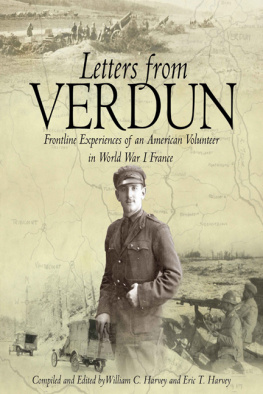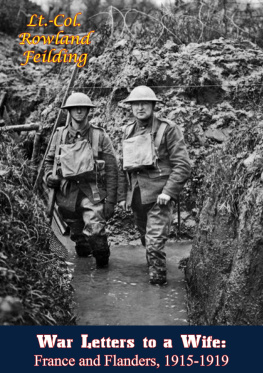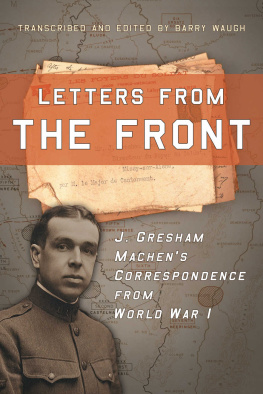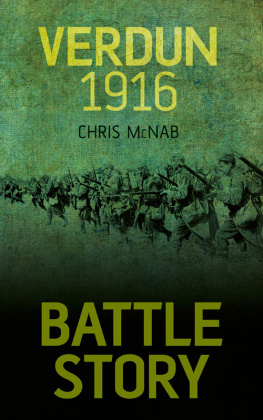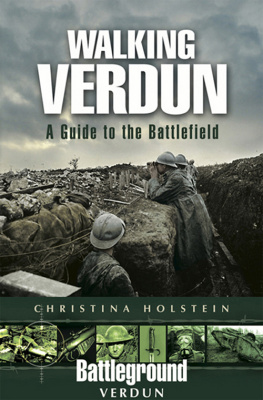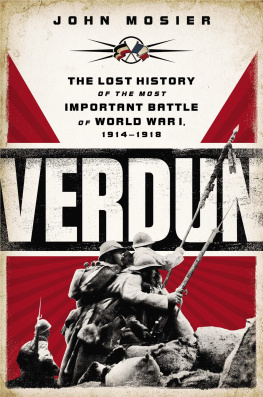William C. Harvey - Letters From Verdun: Frontline Experiences of an American Volunteer in World War 1 France
Here you can read online William C. Harvey - Letters From Verdun: Frontline Experiences of an American Volunteer in World War 1 France full text of the book (entire story) in english for free. Download pdf and epub, get meaning, cover and reviews about this ebook. year: 2009, publisher: Casemate, genre: Non-fiction. Description of the work, (preface) as well as reviews are available. Best literature library LitArk.com created for fans of good reading and offers a wide selection of genres:
Romance novel
Science fiction
Adventure
Detective
Science
History
Home and family
Prose
Art
Politics
Computer
Non-fiction
Religion
Business
Children
Humor
Choose a favorite category and find really read worthwhile books. Enjoy immersion in the world of imagination, feel the emotions of the characters or learn something new for yourself, make an fascinating discovery.
- Book:Letters From Verdun: Frontline Experiences of an American Volunteer in World War 1 France
- Author:
- Publisher:Casemate
- Genre:
- Year:2009
- Rating:5 / 5
- Favourites:Add to favourites
- Your mark:
- 100
- 1
- 2
- 3
- 4
- 5
Letters From Verdun: Frontline Experiences of an American Volunteer in World War 1 France: summary, description and annotation
We offer to read an annotation, description, summary or preface (depends on what the author of the book "Letters From Verdun: Frontline Experiences of an American Volunteer in World War 1 France" wrote himself). If you haven't found the necessary information about the book — write in the comments, we will try to find it.
Letters From Verdun: Frontline Experiences of an American Volunteer in World War 1 France — read online for free the complete book (whole text) full work
Below is the text of the book, divided by pages. System saving the place of the last page read, allows you to conveniently read the book "Letters From Verdun: Frontline Experiences of an American Volunteer in World War 1 France" online for free, without having to search again every time where you left off. Put a bookmark, and you can go to the page where you finished reading at any time.
Font size:
Interval:
Bookmark:
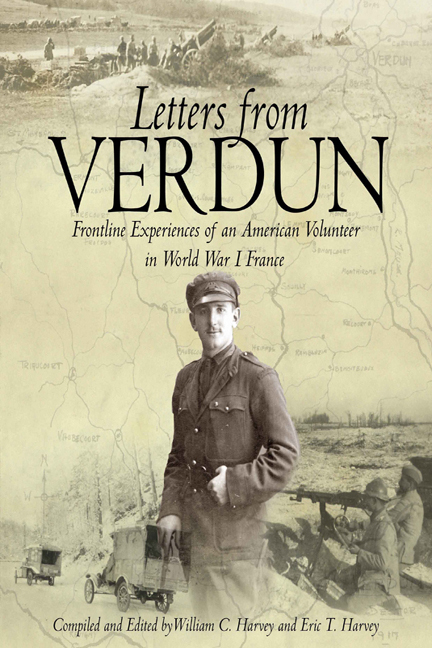


Published in the United States of America and Great Britain in 2009 by
CASEMATE
908 Darby Road, Havertown, PA 19083
and
17 Cheap Street, Newbury RG20 5DD
Copyright 2009 William C. Harvey and Eric T. Harvey
ISBN 978-1-932033-94-6
eISBN 978-1-61200-0282
Cataloging-in-publication data is available from the Library of Congress and the British Library.
All rights reserved. No part of this book may be reproduced or transmitted in any form or by any means, electronic or mechanical including photocopying, recording or by any information storage and retrieval system, without permission from the Publisher in writing.
10 9 8 7 6 5 4 3 2 1
Printed and bound in the United States of America.
For a complete list of Casemate titles please contact:
CASEMATE PUBLISHERS (US)
Telephone (610) 853-9131, Fax (610) 853-9146
E-mail: casemate@casematepublishing.com
CASEMATE PUBLISHERS (UK)
Telephone (01635) 231091, Fax (01635) 41619
E-mail: casemate-uk@casematepublishing.co.uk
Dedication
In memory of Avery Royce Wolfe,
18981977,
a patriot and soldier who left an enduring legacy of military service.
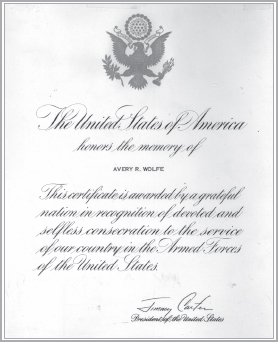
Acknowledgments
Katherine Calabria Harvey generously provided the materials for this volume, and we are equally indebted for her unstinting support and encouragement. We also wish to thank Jane Nearing of the Richardson, Texas, Public Library Research Section for her invaluable assistance, William L. Foley for additional materials from the archives of the William L. Foley Collection, and to Rita P. Harvey for technical assistance.
Preface
Avery Royce Wolfe was born into a middle-class business family on April 30, 1888. He lived in Buffalo, New York, and after his sophomore year at Lafayette College in June 1917, he enlisted as a private in the American Auxiliary Field Service.
In June 1917, 19-year-old Royce Wolfe set out on his great adventure. He sailed on the French liner Touraine from New York City to Bordeaux, and then traveled by train to Paris. He was assigned as an ambulance driver in the American Field Service. He served with the French and then the American Army until his discharge in May 1919.
The American Field Service (AFS) was a volunteer service founded in 1915 by A. Piatt Andrew, an American who wanted to help the French war effort. Under his leadership the organization grew rapidly, often attracting recruits on American college campuses, young men who could establish their unquestioned loyalty to the allied cause, and who were looking for adventure. Because of the organizations partiality, it was not affiliated with the American Red Cross, which was neutral. Approximately 2,500 volunteers joined the AFS, many long before their country entered the war. One hundred and fifty-one of them lost their lives.
Wolfe entered war service with a number of old friends. Early in his correspondence, he takes pains to explain that he would not go into detail about the actual fighting he witnessed. Rather, he would supply a human narrative of life near the front, in exquisite and often surprising detail, depicting the mortal peril facing ambulance drivers as they toiled in the midst of battle to remove wounded men from the field of fire. The testimonials are accompanied by numerous photographs, most of them his own. Several campaigns are shown in the authors own skillfully drawn maps.
Wolfes initial idealistic exuberance matured into a sober but unwavering conviction of the rightness of the Allied cause. Later in the war, his passionate hatred of the Boche moderated to allow a grudging admiration for German engineering and efficiency, but then the experience of conflict brought him to the realization that enemy and ally share a common humanity.
Wolfe spent his entire war service in the center of the Allied front, within miles of the Verdun sector. He won the coveted French Croix de Guerre for his bravery during the final, desperate Ludendorff offensive of June 1918. Here is a curious gap in this otherwise frequent correspondence; in a letter of early July he apologizes for his neglect, saying only that he had been very busy.
Wolfes accounts are competent, detached, and almost clinicalat times poetic and descriptive, and at others more telling in what he doesnt say. His impressions of the soldiers and civilians he meets in foreign parts are an insight into the social and cultural norms of his time. There are touches of dry humor in the poignant homesickness of a young man far from home, pledged to serve for the remainder of the dreadful conflict.
Although the First World War, or Great War, had begun on June 28, 1914, America did not declare war until April 6, 1917, and significant numbers of American troops did not arrive until the summer of 1918. American troops fought in 13 major operations during 200 days of combat, but military tactics had failed to keep pace with military technology, which resulted in a stalemate for much of the war, with enormous casualties sustained on all sides for very little gain. Proportionately more soldiers died of battle wounds than in any war of the previous century. Six men were wounded, taken prisoner, or reported missing for every one killed in battle, but pneumonia still caused more fatalities than combat wounds. In 19 months of campaigning, the American Army suffered 50,000 battle fatalities, 206,000 wounded, and 67,500 deaths due to disease. Five percent of the population living in the U.S. during the First World War served in the armed forces in some way, compared with nearly 12 percent during the Civil War. Two out of every three American soldiers saw action in battle.
The war saw the frightening advent of poison gas as a weapon of mass destruction, though ironically, the toxic mustard and chlorine gasses were relatively humane weapons. Only 200 men died on the battlefield as a result of acute exposure to poison gas, with 2,200 succumbing in field hospitals, these out of 70,000 total gas casualties among American troops. Wolfe relates that some soldiers deliberately exposed themselves in order to obtain a respite from the battlefield. The vast preponderance of victims experienced acute pulmonary symptoms, and a minority went on to develop severe and disabling chronic lung disease. However, the tactical effect on unprotected battlefield troops was devastating, and in 1918, 2030 percent of all casualties were due to exposure to toxic gases.
Twenty-four million men were registered for induction into the armed forces by the Selective Service Law of May 19, 1917, their ages ranging from 18 to 45. One in eight, or 2,800,000, were inducted, and in the course of Americas 19 months of involvement in the war, 2,086,000 Americans were sent overseas, of whom 1,390,000 fought in France.
The division was the main fighting unit of the war and consisted, on average, of 1,000 officers and 27,000 men. Forty-two American divisions were trained and sent to fight overseas, the majority arriving during the last six months of the war and eventually exceeding the British Expeditionary Force in size. Depot Brigades numbering about 10,000 personnel were organized as training and sorting units to process the new men and materials. One in four servicemen was a member of the Services of Supply.
Font size:
Interval:
Bookmark:
Similar books «Letters From Verdun: Frontline Experiences of an American Volunteer in World War 1 France»
Look at similar books to Letters From Verdun: Frontline Experiences of an American Volunteer in World War 1 France. We have selected literature similar in name and meaning in the hope of providing readers with more options to find new, interesting, not yet read works.
Discussion, reviews of the book Letters From Verdun: Frontline Experiences of an American Volunteer in World War 1 France and just readers' own opinions. Leave your comments, write what you think about the work, its meaning or the main characters. Specify what exactly you liked and what you didn't like, and why you think so.

